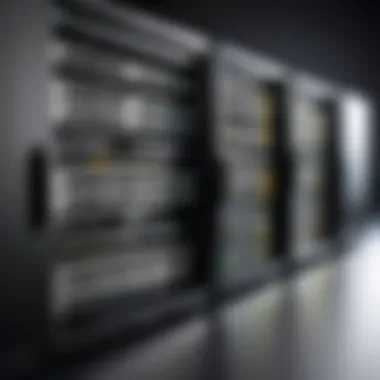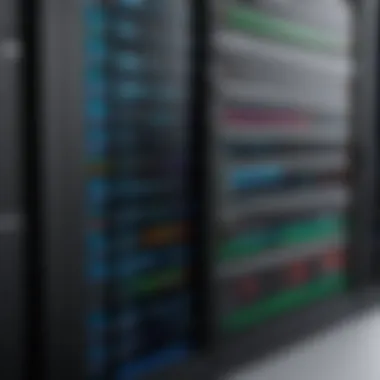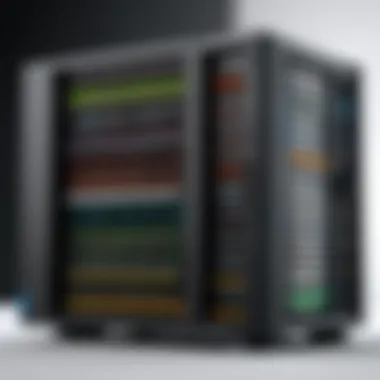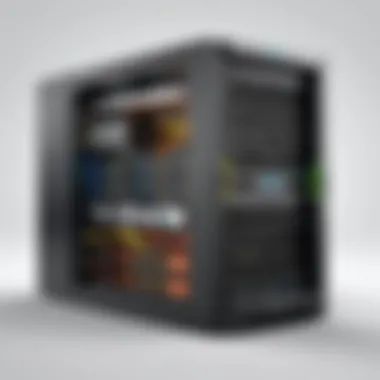Analyzing the Cost Factors of Rack Servers for Businesses


Intro
When considering the rapidly changing landscape of IT infrastructure, rack servers have carved out a niche of their own. These systems not only support critical applications and services but also impose distinct cost dynamics that can catch organizations off guard. For businesses navigating this complex terrain, understanding the intricate details of rack server expenses is not just beneficial; it’s essential.
This article embarks on an exploration of the factors that influence the costs associated with rack servers, demystifying pricing structures that extend far beyond the initial purchase. From operational expenses to often overlooked hidden costs, the financial aspect of rack servers can influence strategic decision-making in a profound way.
As we scaffold our discussion, it's crucial to discern not just the sticker price, but the total cost of ownership. This encompasses insights that can guide technology professionals, IT decision-makers, and even students into making well-informed investment decisions.
Understandably, the cost implications can feel like navigating a maze, but fear not, as each twist and turn will be laid out clearly throughout this analysis.
Preface to Rack Servers
In today’s tech-heavy landscapes, where data flows like water and information is the lifeblood of businesses, rack servers have become a cornerstone of modern IT infrastructure. Understanding rack servers is no mere academic pursuit; it is crucial for anyone involved in technology management or systems administration. As organizations strive for efficiency, flexibility, and scalability, grasping the ins and outs of rack servers presents numerous benefits, ranging from financial prudence to operational effectiveness.
Definition and Overview
Rack servers are computer servers designed to be installed in a framework called a rack. This compact design allows multiple servers to share space and cooling resources, maximizing real estate and enhancing organizational efficiency. They come in various forms, usually measured by the number of units, or "U", that refers to the height of the server. For example, a 1U server is about 1.75 inches high. Its design may seem straightforward, but the implications are profound, especially when it comes to setup and maintenance.
A proper understanding of rack servers means grasping their role in supporting critical applications, from websites to enterprise resource planning systems. They often provide specialized functionalities, and their modularity means businesses can scale operations without significant overhauls in infrastructure.
The Role of Rack Servers in Modern IT
Rack servers play a pivotal role in shaping contemporary IT environments. They serve as the backbone for data centers, where high-performance and reliability are non-negotiable. The rise of cloud computing and virtualizations techniques has further reinforced the significance of rack servers, making them a preferred choice for hosting applications and services.
Here are several reasons why rack servers are essential:
- Efficiency: Their design is optimized for space and power. This can lead to improved energy savings in data centers, an important consideration for many organizations today who wish to reduce operational costs.
- Scalability: Unlike traditional server setups, rack servers facilitate easy expansion. As a business grows, adding new units is a lot more seamless, allowing for scalability that aligns with growth spurts.
- High Performance: Many rack servers provide superior performance, making them suitable for tasks that require heavy computations, such as machine learning and big data analytics.
- Centralized Management: With rack servers, components can be managed from a single point. This centralization simplifies maintenance and troubleshooting, saving both time and resources.
While the initial investment in rack servers may seem daunting, their long-term value becomes apparent when considering total cost of ownership. As a foundational element of IT infrastructure, understanding rack servers aids organizations in making informed decisions on technology investments.
"The true value of rack servers extends beyond their price tag, influencing efficiency, scalability, and performance for businesses as they evolve."
This exploration into the fundamental concepts of rack servers establishes a critical understanding of their importance, preparing us to investigate the factors that drive their costs. With the framework laid out, let's delve deeper into what influences the financial dynamics of rack servers.
Factors Influencing Rack Server Costs
When considering the financial implications of rack servers, it’s vital to understand the myriad of factors that can sway overall costs. From the very first dollar spent to the cumulative expenses over the operational lifetime of the rack servers, these factors shape not just the budget but the kind of performance and scalability a business might ultimately achieve. Not paying heed to these elements could lead to unexpected budgetary constraints and operational hiccups.
Initial Purchase Price
The initial purchase price is obviously a cornerstone component when acquiring rack servers. It encompasses not just the price tag of the hardware itself but also includes some ancillary elements. For instance, does the purchase include warranty services? Are there initial setup or configuration fees? The cost can differ significantly based on the specifications, features, and processing power of the server.
Moreover, while some might lean towards cheaper options, they might overlook long-term implications. A less expensive server could require more frequent repairs or might fall short on performance during peak workloads, which can lead to greater costs down the road. Ultimately, the initial investment shouldn’t just be about what you’re paying now but what you’re getting for that price.
Configuration and Customization
The flexibility of configuration and customization options available for rack servers can be both a blessing and a cost driver. Organizations often have specific demands—some may need extra storage while others require enhanced computing power. Custom configurations allow companies to tailor systems to their unique needs but can ramp up costs quickly. Adding memory or upgrading processors often leads to significant price increases.
Furthermore, adapting servers to seamlessly integrate with existing infrastructure also demands consideration. Each adjustment or enhancement can potentially alter the total expenditure. For instance, if a business opts for a modular setup that allows for future upgrades, they must be prepared for upfront investments that could pinch budgets bit by bit.
Brand Considerations
Brand reputation is another implicit factor influencing rack server costs. Some brands, like Dell and HPE, command higher prices, not merely for the hardware but also for associated software, customer service, and long-standing industry trust. However, lesser-known brands may present attractive pricing but could come with their own pitfalls—such as subpar support or slower performance under strain.
It's crucial to balance brand loyalty with pragmatic considerations. A well-known brand might offer a premium experience, but if a lesser-known alternative provides similar specifications and guarantees a reliable service, it can save a considerable chunk of change. In the end, every decision on brand should be informed not just by cost but by performance expectations and after-sales service, ensuring that any savings don’t come at the price of reliability.
Key Points to Consider:
- Initial purchase costs reflect more than just hardware.
- Custom configuration can lead to upselling; plan accordingly.
- Brand reputation may add a premium but consider value comprehensively.
In summary, these factors interplay in complex ways, and recognizing their impact on rack server costs can help businesses make smarter financial decisions. The clearer your understanding of each aspect, the better positioned you are to secure a reliable IT infrastructure that aligns with both current and future needs.
Operational Costs of Rack Servers


Operational costs represent a significant part of the overall expenditure for rack server management. It includes not just the initial investment but also ongoing expenses that can accumulate over time, impacting budget forecasts and profitability.
Understanding these costs helps businesses make well-informed decisions and avoid hidden financial pitfalls.
Energy Consumption and Efficiency
Rack servers, by their very nature, demand a considerable amount of energy. Despite advancements in energy efficiency, managing power consumption remains a crucial concern for enterprises. The little things can add up; for instance, each server in a rack demands a steady power supply for both processing and cooling.
"A penny saved is a penny earned," they say, but with rack servers, it’s more about kilowatts than cash, at least initially.
Implementing energy-efficient technologies not only minimizes costs but also contributes positively to environmental sustainability. Companies can opt for energy-efficient components like low-power CPUs, and high-efficiency power supplies. It's all about striking that balance between performance and cost-efficiency.
Key Considerations:
- Monitoring Tools: Employing software for real-time tracking of energy consumption can provide insights into usage patterns.
- Cooling Solutions: Proper ventilation and cooling systems can reduce the energy needed for temperature control, directly impacting costs.
Maintenance and Support
The nuts and bolts of running rack servers go way beyond just powering them on. Maintenance and support are ongoing operational legacies that demand attention. Companies often assume that once a server is installed, the costs diminish. However, the reality reflects otherwise.
Regular maintenance not only prolongs the lifespan of the equipment but also ensures optimal performance. Having reliable support services in place is crucial in reducing downtime, which can be financially detrimental. Consider having a contract with a reputable service provider for immediate on-site assistance.
Maintenance Aspects Include:
- Routine Checks: Scheduled inspections can identify potential issues before they escalate into significant problems.
- Software Updates: Keeping system software updated mitigates security risks and improves functionality.
- Hardware Upgrades: Components should be upgraded or replaced as needed to prevent sluggish performance.
Replacement Parts
Even the best server systems can experience wear and tear over time. Replacement parts are inevitable expenses many organizations often fail to account for when budgeting.
This aspect can lead to unforeseen costs which can strain operations if not properly managed. Understanding the lifecycle of each component, alongside sprung costs can help in predicting and budgeting accordingly.
Considerations for Replacement Parts:
- Warranty Factors: Some brands offer valuable warranties on their components, potentially saving costs in the long run.
- Vendor Relationships: Establishing strong connections with vendors can lead to better deals for parts, reducing overall expenditure.
- Stock Issuing: Keeping a stock of frequently replaced parts can minimize downtime but needs to be inventoried wisely to avoid unnecessary holding costs.
In summary, operational costs of rack servers deserve careful consideration. Recognizing the nuances of energy consumption, maintenance needs, and the inevitability of replacement parts leads to better decision-making and efficient use of resources.
Understanding Total Cost of Ownership
When businesses look into buying rack servers, the initial cost often steals the spotlight. However, the Total Cost of Ownership (TCO) sheds light on the broader financial picture. TCO encompasses every dollar spent from the moment a rack server is purchased to its eventual retirement. This perspective is critical because it can guide organizations in making choices that align closely with both their fiscal resources and operational requirements.
Understanding TCO isn’t just about understanding how much you’ll spend in the long run; it’s about identifying unseen expenses that can sneak up and surprise budgets. These costs include energy consumption, maintenance fees, software licenses, and potential downtime expenses. Moreover, factoring in the lifespan and turnover rate of hardware can help to evaluate whether it’s better to buy or lease.
Initial vs. Ongoing Costs
The breakdown of costs starts with the initial purchase. This involves the price of the hardware itself including any setup costs and initial configuration. Yet, if organizations stop here, they risk underestimating the financial commitment they’re undertaking.
Ongoing costs can vary remarkably based on the setup and utilization. Here’s a look at critical ongoing expenses:
- Energy Costs: Servers consume power 24/7. Depending on the efficiency of the equipment and local electricity rates, this could range from significant monthly fees to more manageable charges.
- Maintenance and Upkeep: Regular maintenance should not be neglected. This may include hardware repairs, software updates, and occasional upgrades which safeguard performance.
- Support Services: Whether through a dedicated internal team or outsourced professionals, having reliable support can prevent downtime and ultimately save money in the long run.
It’s worthwhile to create a cost breakdown table, providing clarity on how initial costs stack against ongoing expenses beyond the first year of use. Businesses might find that a seemingly inexpensive rack server can lead to hefty long-term costs.
Depreciation and Resale Value
Now, let’s talk about how rack servers age. The depreciation of technology isn’t merely academic; it’s a financial reality. Typically, hardware declines in value as newer, more efficient options take their place. Understanding the expected resale value can thus influence initial decisions. Depreciation models vary; however, many companies adopt a straight-line approach, averaging out the value decrease over the expected life span.
Assessing the resale potential at the end of a rack server’s life is equally essential. If a server retains a substantial fraction of its initial value, this will offset the overall TCO significantly. Effective management of rack servers can enhance their ability to sell post-usage, realizing some returns on that initial investment.
"A penny saved is a penny earned," and when it comes to technology, being informed about the lifecycle of your rack servers can mean saving far beyond the purchase price.
Grab a few metrics from your server’s manufacturer or industry reports on depreciation rates. This will help provide a more accurate estimate for budget forecasting.
Understanding TCO leads to richer insights for both current and future tech investments. Sinking time into exploring these costs can result in significant advantages for firms navigating their technological pathways.


Scalability and Future-Proofing
In the realm of IT infrastructure, scalability and future-proofing are not just buzzwords; they represent critical pillars for businesses looking to optimize their rack server investments. As organizations expand or pivot in response to market demands, the ability to scale systems efficiently becomes paramount. This is especially true in sectors where data processing needs can fluctuate dramatically, such as finance, e-commerce, or cloud computing solutions.
Positioning for Growth
When thinking about rack servers, scalability means being prepared for growth without breaking the bank or compromising efficiency. Organizations should be mindful of how many additional servers they might need in the future. A well-designed rack system should accommodate not just current requirements, but potential expansions as well.
Each rack unit’s density can impact how much space the servers will occupy. It’s a smart move to opt for rack servers that allow for future inserts or modules. This modular approach can save significant time and costs, especially when businesses experience growth spurts.
It is equally important to consider ease of management when scaling. The chosen infrastructure should facilitate the quick addition of equipment, without needing a complete overhaul of existing systems. For those eyeing growth, seeking out vendors that offer flexible upgrade paths and customization options can make a world of difference.
- Key considerations for positioning:
- Modular design to allow for quick upgrades.
- Vendor options that support future technologies.
- Assessment of current and projected server load.
Adapting to Technological Advances
Technological evolution waits for no one; therefore, businesses must be savvy in how they approach rack server investments. With advancements moving at breakneck speed, organizations should prioritize solutions that remain relevant over time. Consider how cloud computing and hyper-converged infrastructure have changed the landscape. Rack servers that are innately adaptable to these disruptions can provide a significant edge.
Choosing systems that support newer tech standards, such as NVMe for storage and faster networking capabilities, isn't just about keeping up; it’s a strategy to stay competitive. Compatibility with future software updates and hardware can be a deal-breaker when evaluating long-term investments.
Organizations might also want to keep an eye on convergence technologies, as they can facilitate smoother transitions to new operational models. This ensures the server deployment not only meets today’s needs but is also equipped to leverage innovations as they arrive.
Important Note: Always assess your infrastructure’s adaptability to avoid costly migrations in the future.
- Pro tips for adapting:
- Evaluate existing compatibility with emerging technologies.
- Seek scalable options that evolve with software updates.
- Consider industry trends when designing your server strategy.
Incorporating scalability and future-proofing into rack server planning isn't merely a recommendation; it’s a necessity. The ever-changing landscape demands a proactive approach that anticipates growth and technological advancements. By being strategic about scalability, organizations can not only secure their current investments but also pave the way for sustained success and innovation.
Case Studies in Rack Server Implementation
Understanding the nuances of rack server implementation offers invaluable insights, particularly through real-world examples. Case studies shed light on the tangible benefits and drawbacks that various organizations face when they adopt these systems. They reveal how different environments—be it a small startup or a massive enterprise—approach rack server solutions. This section emphasizes how these practical examples can guide decision-making for others in similar circumstances.
Small Business Cisco Adoption
For small businesses, choosing the right technology partner can make or break their operational efficiency. Take, for instance, ABC Tech, a modest but tech-savvy startup that opted to adopt Cisco rack servers to streamline its data operations. Prior to this decision, ABC Tech used standard desktop computers to handle their backend processes, but as their customer base started exploding, it became clear that their setup was no longer cutting it.
Cisco’s reputation for reliability persuaded them to invest in a rack server solution. The implementation process was fairly straightforward, in part due to Cisco's robust documentation and customer support. They discovered several immediate benefits:
- Increased Efficiency: The transition allowed them to process client requests faster, delivering services that satisfied their users.
- Scalability: With Cisco’s architecture, the business could easily add additional servers as growth dictated.
- Cost-Effectiveness: Initially, the costs were daunting, however, by consolidating resources, they successfully reduced their overheads in the long run.
Despite some teething problems during implementation, like minor configuration setbacks, the overall feedback remained positive. This case demonstrates that even smaller entities can benefit from a thoughtful rack server strategy when coupled with the right brand and technology approach.
Enterprise-Level Implementations
Let’s pivot to a more expansive scenario involving a multinational corporation like XYZ Enterprises. With multiple global branches and a diverse range of services, their IT infrastructure needed to be robust and resilient. XYZ Enterprises decided to invest significantly in a tailored rack server setup to handle a mountainous load of data across its networks.
This implementation took a turn-to-crucial tracks:
- Customized Solutions: They chose to work with a vendor offering bespoke configurations, allowing them to match the hardware specification to the business requirements. Every branch was unique in its needs, and they capitalized on that.
- Advanced Management Tools: The integration of advanced management tools made overseeing thousands of servers manageable. The organization could monitor performance, uptime, and maintenance remotely.
- Enhanced Security: With cybersecurity being a top concern, XYZ Enterprises took layered protection measures, ensuring that their rack servers were fortified against potential breaches.
While the upfront expenses were considerable, the long-term advantages started to outweigh the costs. The perks of a homogeneous server environment fostered a level of simplicity in the management of their IT ecosystem that they hadn't experienced before.
This example serves as a reminder that successful rack server implementation isn’t just about slapping together hardware; it’s about an organizational view of how these systems fit into a larger picture of growth and scalability. The practical knowledge gleaned from these stories guides others—large or small—in navigating their own technology journeys.
Rental and Leasing Options
In the realm of IT infrastructure, the conversation around rack servers often gravitates towards ownership. Yet, taking a detour into rental and leasing options can open new avenues for orgqanizations looking to balance their financial commitments with technological needs. This section explorse why considering these alternatives is crucial in today's fast-paced digital age, where flexibility and cost-management are paramount.
Cost-Effective Solutions


Leasing or renting rack servers can be a savvy financial move. It's often likened to paying rent instead of buying a house—you preserve capital for other investments. Here’s a closer look at some cost-effective solutions that emerge from this approach:
- Lower Upfront Costs: Leasing typically requires a significantly smaller initial outlay compared to outright purchase. Businesses often benefit from this, as they can allocate resources to more immediate needs—like personnel or software development.
- Ease of Budgeting: With predictable monthly payments, budgeting becomes simpler. Companies can anticipate costs instead of facing unexpected expenditures for repairs or upgrades that may arise from owning hardware.
- Access to Latest Technology: Tech is evolving rapidly. Leasing enables organizations to stay on top of trends by transitioning to newer models at the end of a lease term without significant penalties.
- Scalability and Flexibility: Whether an organization is expanding operations or downsizing, renting allows for greater flexibility. You can adjust the number of servers leased according to immediate demand without the burden of unused hardware.
Leasing essentially becomes a pick-and-choose buffet where businesses can quickly adjust their server requirements based on current needs, a major advantage in the volatile landscape of tech procurement.
Pros and Cons of Leasing
When weighing the choice between leasing and purchasing, one must consider both the advantages and disadvantages:
"Leasing can provide the needed agility, but it also ties you to terms that may impact long-term planning."
Pros
- Lower Risk of Obsolescence: The tech world shifts like quicksand. Leasing often comes with regular updates and maintenance included, meaning organizations can dodge the headache of outdated hardware.
- Taxes and Deductions: Lease payments can frequently be deducted as business expenses, potentially lowering taxable income. It's always prudent to consult a financial adviser to optimize these benefits.
- Potential Support Services: Many leases offer supplementary support services, ensuring that any issues encountered don’t derail operations.
Cons
- Long-Term Costs: Over an extended period, leasing can sometimes lead to spending more than purchasing outright. The total cost may outstrips the expense of ownership if servers are kept beyond their lease period.
- Contractual Obligations: Leasing agreements can have strict terms. Breaking a lease or overages might come with penalties which can blindside an organization if not carefully scrutinized.
- Limited Control and Customization: Owners of hardware have the liberty to customize their equipment as desired. Renters may find that options for customization are limited based on the lease terms.
Additional Considerations
When talking about the costs associated with rack servers, some finer points often don’t get the attention they deserve. These considerations, while sometimes brushed aside, play a critical role in shaping the total effective cost of ownership. Two major facets stand out in the discussion: security and compliance costs, and the environmental impact and sustainability of server operations.
Security and Compliance Costs
In today’s digital landscape, security isn’t just a buzzword; it’s the bedrock of trustworthy IT systems. Investing in rack servers means understanding the security measures necessary to safeguard data. This isn’t just about firewalls or antivirus software. Rack servers manage sensitive information, and thus, complying with data protection regulations like GDPR or HIPAA can lead to considerable costs that might not be immediately obvious.
Certain practices and tools need to be employed to bolster security. For instance:
- Regular Security Audits: Periodic checks ensure that vulnerabilities are identified and patched, but they can also incur ongoing fees.
- Employee Training: Keeping staff informed about security protocols is essential, more so in environments where people might not be entirely tech-savvy.
- Insurance Policies: Coverage against data breaches is increasingly becoming a necessity, adding another layer of cost.
Furthermore, failure to comply with regulations can lead to significant penalties that far outweigh the initial investments. Thus, when evaluating costs, it’s vital to factor in potential legal implications alongside the direct expenses of security measures.
"The only thing worse than a data breach is the aftermath, where costs swell due to fines and loss of client trust."
Environmental Impact and Sustainability
With climate change becoming hard to ignore, sustainability is high on the corporate agenda. Rack servers, while efficient on paper, come with their own environmental footprint. Understanding their impact not only plays well with corporate social responsibility (CSR) but also paves the way for potential cost savings down the line.
Here are some points to think about:
- Energy Efficiency: Older rack servers might consume more power. Upgrading to newer models can be more costly upfront, but if they significantly reduce energy costs, the payback period might be faster than expected.
- E-Waste Management: Disposing of servers can lead to additional costs. Keeping an eye on the lifecycle of hardware and ensuring proper recycling aligns both with sustainability goals and cost control.
- Compliance with Environmental Regulations: Just as with security, local laws regarding electronic waste and carbon emissions can affect operational costs. Companies that practice sustainability often find they have fewer penalties related to non-compliance.
By peppering sustainability measures into the operational framework, businesses can not only contribute positively to the environment but also create a more cost-effective operational model.
Allocating resources to these additional considerations can lead to a clearer understanding of the full breadth of costs tied to rack servers. Having a grasp on these aspects ultimately ensures better budgeting and financial planning for IT infrastructure.
Ending: Making Informed Decisions
Deciding on the right rack server essentially boils down to weighing costs against organizational needs. Each business has its own set of requirements. For example, a small startup might prioritize budget over performance, while a large enterprise may look for scalability and reliability. Identifying what is essential for your operations can lead to better investment outcomes.
- Performance Needs: Beyond the upfront prices, companies must consider the performance level required to handle their workloads effectively.
- Scalability: As businesses grow, their needs evolve. The right system should support scaling up without causing financial strain later on.
- Operational Efficiency: Investing in hardware that minimizes operational costs can lead to considerable savings long-term.
Ultimately, the goal is to create a balanced viewpoint where all factors—initial costs, ongoing expenses, potential savings, and long-term benefits—are taken into account. Being too hasty can lead to overspending on features that may not be necessary while underselling essential capabilities can put performance and reliability at risk.
"The best decision is one made with all variables in mind."
Weighing Costs Against Needs
When it comes to purchasing or leasing rack servers, making decisions based solely on price can be a double-edged sword. A bargain might save some bucks in the short run but could quite possibly backfire due to hidden costs or inadequate performance capabilities. Here are some critical points to consider:
- Identify Core Needs: Each organization should evaluate its specific workloads and performance needs before diving into financial figures. List down expected future requirements—not just current ones.
- Analyze Total Cost of Ownership (TCO): Initial costs tend to grab more attention, yet ongoing expenditures like maintenance, power consumption, and upgrades could balloon over time.
- Consider Flexibility: Choose a setup that can adapt as your company evolves. A slightly higher upfront investment might yield substantial returns down the line if the infrastructure is manageable.
Future Trends in Rack Server Costs
Looking ahead, rack server costs are not only shaped by technological advancements but also by market dynamics. Emerging technologies can shift the landscape in unexpected ways. A few important trends worth noting:
- Rise of Modern Architectures: Solutions like hyper-converged infrastructure are becoming more common, which may alter traditional cost structures.
- Increased Focus on Energy Efficiency: As companies target sustainability, these considerations are increasingly integrated into purchasing decisions. Energy-efficient models can reduce operational costs over time.
- Cloud Integration: The blending of on-premise and cloud solutions suggests a potential dip in demand for physical hardware, which could lower prices.
It's imperative for businesses to keep an eye on these trends while assessing their own needs and existing infrastructure. Changes in technology are rapid, and a wait-and-see attitude could lead to missed opportunities in optimizing costs.







